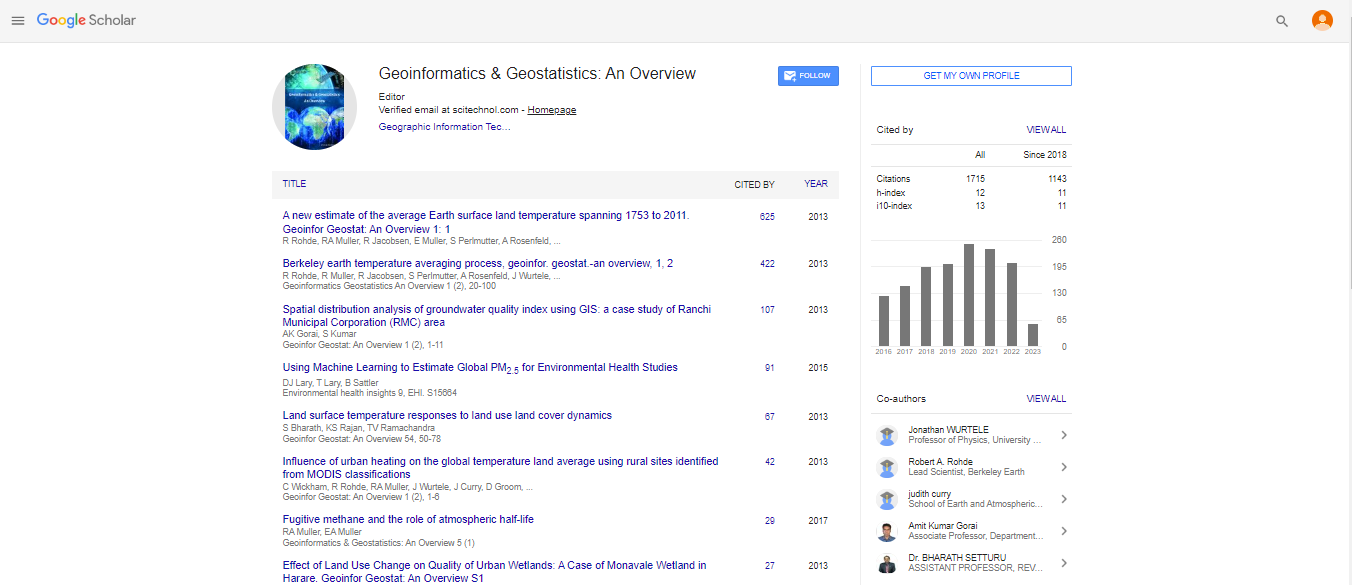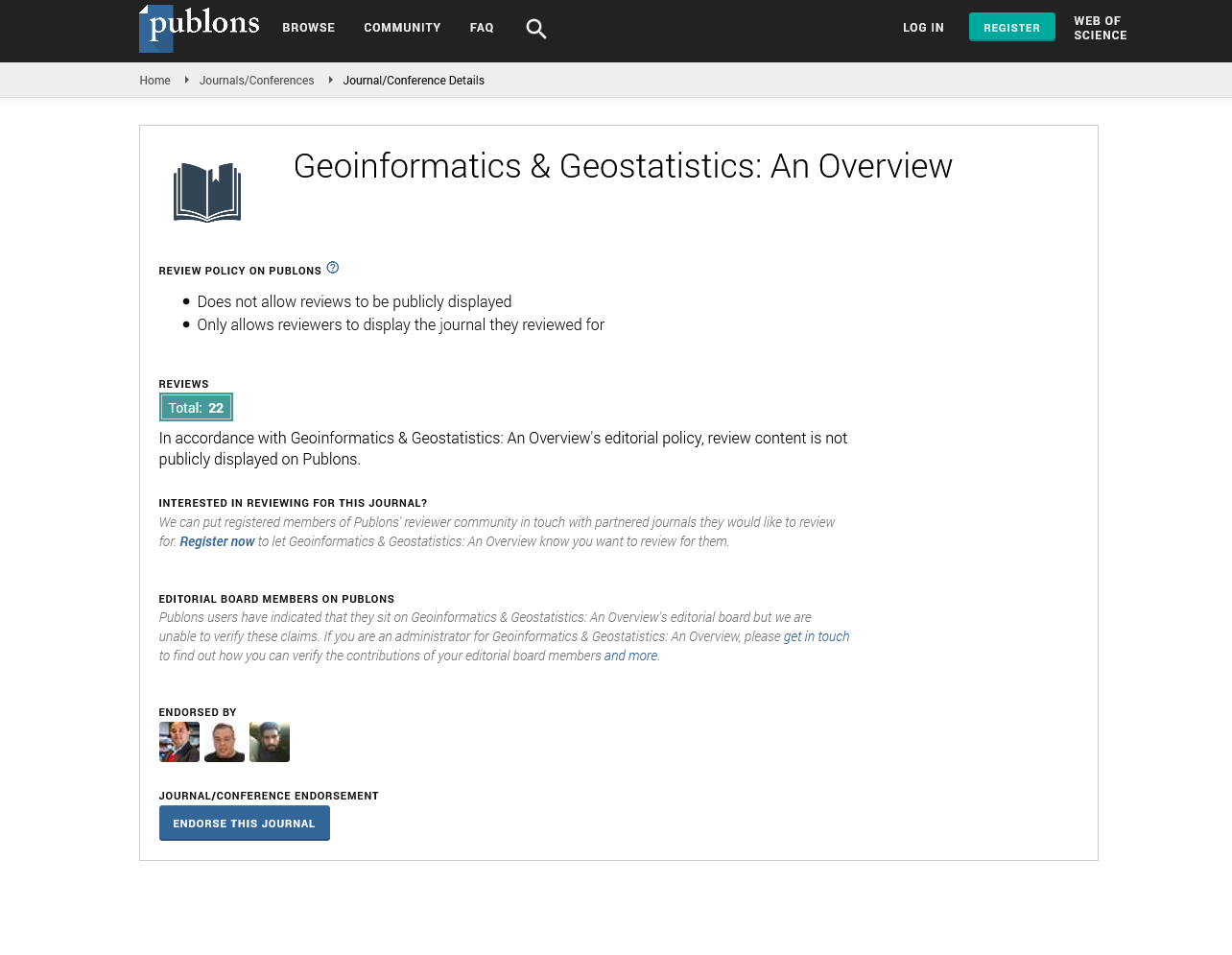Perspective, Geoinfor Geostat An Overview Vol: 10 Issue: 2
Remote Sensing the Accession of Information
Ahmad Almasi*
Department of Geosciences and Natural Resource Management, University of Copenhagen, Copenhagen, Denmark
*Corresponding Author:
Ahmad Almasi
Department of Geosciences and Natural Resource Management, University of Copenhagen, Copenhagen, Denmark
E-mail:ahmadalmasi@gmail.com
Received: 18 January, 2022, Manuscript No. GIGS-22- 57725;
Editor assigned: 20 January, 2022, PreQC No. GIGS-22-57725 (PQ);
Reviewed: 31 January, 2022, QC No GIGS-22-57725;
Revised: 10 February, 2022, Manuscript No. GIGS-22-57725 (R);
Published: 20 February, 2022, DOI: 10.4172/2327-4581.1000278
Citation: Almasi A (2022) Remote Sensing the Accession of Information. Geoinfor Geostat: An Overview 10:2.
Keywords: Remote Sensing, Spatial resolution, Geo-spatial Intelligence, Spatial Decision Support Systems
Introduction
Remote seeing is the accession of information about an object or miracle without making physical contact with the object in discrepancy to in situ or on- point observation. The term is applied especially to acquiring information about the Earth and other globes. Remote seeing is used in multitudinous fields including terrain, land surveying and utmost Earth wisdom disciplines it also has military, intelligence, marketable, profitable, planning, and philanthropic operations, among others.
In current operation the term remote seeing generally refers to the use of satellite or aircraft- grounded detector technologies to descry and classify objects on Earth. It includes the face and the atmosphere and abysses, grounded on propagated signals. It may be resolve into active remote seeing and unresisting remote seeing when the reflection of sun is detected by the detector. Remote seeing can be divided into two types of styles passive remote seeing and Active remote seeing. Passive detectors gather radiation that's emitted or reflected by the object or girding areas. Reflected sun is the most common source of radiation measured by unresisting detectors. Exemplifications of unresisting remote detectors include film photography, infrared, charge- coupled bias, and radiometers. Active collection, on the other hand, emits energy in order to overlook objects and areas whereupon a detector also detects and measures the radiation that's reflected or backscattered from the target. RADAR and LIDAR are exemplifications of active remote seeing where the time detention between emigration and return is measured, establishing the position, speed and direction of an object. Remote seeing makes it possible to collect data of dangerous or inapproachable areas. Remote seeing operations include covering deforestation in areas similar as the Amazon Basin, glacial features in Arctic and Antarctic regions, and depth sounding of littoral and ocean depths. Military collection during the cold war made use of stage-off collection of data about dangerous border areas. Remote seeing also replaces expensive and slow data collection on the ground, icing in the process those areas or objects aren't disturbed. Orbital platforms collect and transmit data from different corridor of the electromagnetic diapason, which in confluence with larger scale upstanding or ground- grounded seeing and analysis, provides experimenters with enough information to cover trends similar and other natural long and short term marvels. Other uses include different areas of the earth lore similar as natural resource operation, agrarian fields similar as land operation and conservation, hothouse gas monitoring, canvas slip discovery and monitoring, and public security and outflow, ground-grounded and stand-off collection on border areas.
Operations of Remote Seeing
Conventional radar is substantially associated with upstanding business control, early warning, and certain large-scale meteorological data. Doppler radar is used by original law enforcements monitoring of speed limits and in enhanced meteorological collection similar as wind speed and direction within rainfall systems in addition to rush position and intensity. Other types of active collection include tubes in the ionosphere. Interferometry synthetic orifice radar is used to produce precise digital elevation models of large scale terrain.
Ray and radar altimeters on satellites have handed a wide range of data. By measuring the bulges of water caused by graveness, they collude features on the seafloor to a resolution of an afar or so. By measuring the height and wavelength of ocean swells, the altimeters measure wind pets and direction, and face ocean currents and directions. Ultrasound and radar drift needles measure ocean position, runs and surge direction in littoral and coastal drift needles.
Light Discovery And Ranging (LIDAR) is well known in exemplifications of armament ranging, ray illuminated homing of shells. LIDAR is used to descry and measure the attention of colorful chemicals in the atmosphere, while airborne LIDAR can be used to measure the heights of objects and features on the ground more directly than with radar technology. Foliage remote seeing is a top operation of LIDAR.
Radiometers and photometers are the most common instrument in use, collecting reflected and emitted radiation in a wide range of frequentness. The most common are visible and infrared detectors, followed by fryer, gamma- shaft, and infrequently, ultraviolet. They may also be used to descry the emigration gamut of colorful chemicals, furnishing data on chemical attention in the atmosphere. Hyper spectral imaging produces an image where each pixel has full spectral information with imaging narrow spectral bands over a conterminous spectral range. Hyper spectral imagers are used in colorful operations including mineralogy, biology, defense, and environmental measures.
Within the compass of the combat against desertification, remote seeing allows experimenters to follow up and cover threat areas in the long term, to determine desertification factors, to support decision-makers in defining applicable measures of environmental operation, and to assess their impacts.
Spatial resolution
The size of a pixel that's recorded in a raster image – generally pixels may correspond to square areas ranging in size length from 1 to meters (3.3 to ft.).
Spectral resolution
The wavelength of the different frequence bands recorded – generally, this is related to the number of frequence bands recorded by the platform. Current Landsat collection is that of seven bands, including several in the infrared diapason, ranging from a spectral resolution of0.7 to2.1 μm. The Hyperion detector on Earth Observing-1 resolves 220 bands from0.4 to2.5 μm, with a spectral resolution of0.10 to0.11 μm per band.
Radiometric resolution
The number of different intensities of radiation the detector is suitable to distinguish. Generally, this ranges from 8 to 14 bits, corresponding to 256 situations of the argentine scale and up to intensities or tones of color, in each band. It also depends on the instrument noise.
Temporal resolution
The frequency of flyovers by the satellite or airplane, and is only applicable in time-series studies or those taking an averaged or mosaic image as in stripping monitoring. This was first used by the intelligence community where repeated content revealed changes in structure, the deployment of units or the revision/ preface of outfit. Pall cover over a given area or object makes it necessary to repeat the collection of said position.
 Spanish
Spanish  Chinese
Chinese  Russian
Russian  German
German  French
French  Japanese
Japanese  Portuguese
Portuguese  Hindi
Hindi 
